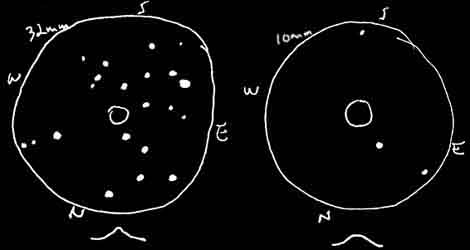
Observation Notes:
This was a small, dim globular cluster–at least in the horrible conditions I was viewing: low in the sky, in an areas of heavy light pollution, and bad seeing to top it off. I couldn’t see any granularity, or aberration in shape. It just appeared soft and spherical at 37X and 120X.
Factoids:
M80 is 27,400 light years away, is roughly 95 light years in diameter, and contains several hundred thousand stars. It is one of the densest globular clusters in the Milky Way. It contains a large number of “Blue Straggler” stars in its core. These stars appear to be more massive and younger than the main population of stars in the cluster. It is suspected that a high rate of stellar collisions in the core of the cluster are stripping the cooler envelopes from stars to give rise to these stragglers.
Charles Messier discovered it in 1870, and noted it as a “nebula without a star…”. William Herschel was the first to resolve it into stars before 1875.
| Subject | M80/NGC 6093 |
| Classification | Globular Cluster |
| Position | Scorpius [RA: 16:17.0 / Dec: -22:59]* |
| Size* | 10′ |
| Brightness* | 7.3 |
| Date/Time | 10/15/04 – 7:55 PM |
| Observing Loc. | Flagstaff, AZ – Home |
| Instrument | Orion SVP 6LT Reflector (150 mm dia./1200 mm F/L) |
| Eyepieces/Mag. | 32 mm (37X); 10 mm (120X) |
| Seeing | 3/10 |
| Transparency | Mag 5.8 |
* Based on published data.